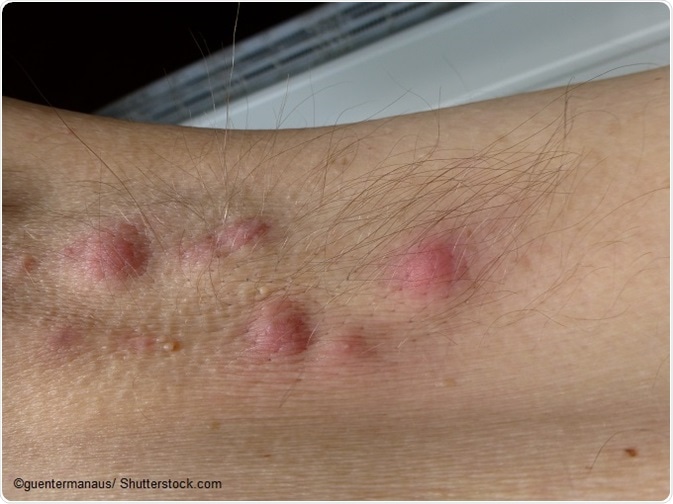where to buy cheap desyrel ca no prescription
Hidradenitis supurativa, also known as acne inversa, is a chronic skin condition involving the inflammation of the apocrine sweat glands, forming pimple-like bumps known as abscesses. These tend to recur in specific regions of the body, can be very painful and often leave behind deep scar tissue when they heal.

Cause
The cause of hidradenitis supurativa is not known, although there are several factors that are thought to be involved in the pathophysiology of the condition. These include:
- Genetics
- Hormonal imbalances
- Obesity
- Smoking
There are also some other health conditions that are linked to hidradenitis supurativa and individuals that suffer from these are more likely to be affected by the skin disease. Crohn’s disease, in particular, is associated with a higher risk and is thought to stimulate the progression of hidradenitis supurativa.
Symptoms
The hallmark sign of hidradenitis supurativa is the formation of abscesses that can be very painful and ooze pus when ruptured. They typically appear in specific areas of the body, such as the groin, armpits or underneath the breasts.
Initially, a single lesion in one region will appear, which may resolve within 15-30 spontaneously or rupture and leak pus. It is common for scar tissue to form when the lesion clears. More abscesses will likely recur in the same region and sinus tracts may form as the disease progresses, which are narrow channels of pus underneath the skin.
In some cases, bacteria can colonise the lesions and lead to an infection of the area, increasing the production of pus and symptoms of pain.
Stages of Progression
Hidradenitis supurativa can be classified according to the stage of progression of the disease, as follows:
- Hurley stage 1: Single or a few lesions with no evidence of scarring or sinus tracts.
- Hurley stage 2: Recurrent abscesses in several areas of the body and initial formation of sinus tracts.
- Hurley stage 3: Many abscesses throughout the body with evidence of scarring and pus, as well as a network or sinus tracts under the skin.
These stages help to understand the severity of the condition and guide the treatment decisions to manage the symptoms.
Treatment
There are many different treatments that may be used in the management of hidradenitis supurativa with varied success. Most patients find they need to trial several options before finding the most effective solution to prevent their symptoms.
Initial treatment usually begins with simple lifestyle changes to help reduce the number of lesions and the severity of symptoms. This may include losing weight, stopping smoking, eating well, avoiding irritants and wearing loose-fitting clothing.
These is a wide range of pharmaceutical options available, such as:
- Acne washes (e.g. benzoyl peroxide)
- Bleach baths to eradicate colonizing bacteria
- Antibiotics to manage inflammation and bacterial infection
- Hormonal therapy to regulate hormone and reduce breakouts
- Retinoid medications (e.g. acitretin) to reduce sebum secretion
- Metformin to manage patients with metabolic syndrome
- Corticosteroids (e.g. prednisolone) to relieve pain and inflammation and prevent new breakouts
- Biologic medications (e.g. adalimumab) to reduce symptoms of patients with a severe form of the disease
- Methotrexate to regulate the immune system and manage symptoms
Additionally, some patients may require surgery to treat severe cases of hidradenitis supurativa. Depending on the individual circumstances, the procedure may involve laser surgery, cytotherapy, deroofing, drainage, incision or excision.
The ideal treatment is highly variable and most patients will need to trial several different options before finding the best solution to help control outbreaks and increase their quality of life.
References
- http://patient.info/health/hidradenitis-suppurativa-leaflet
- http://www.nhs.uk/conditions/hidradenitis-suppurativa/Pages/Introduction.aspx
- https://www.aad.org/public/diseases/painful-skin-joints/hidradenitis-suppurativa
- http://www.ncbi.nlm.nih.gov/pmc/articles/PMC3573446/
Further Reading
- All Hidradenitis supurativa Content
- Hidradenitis suppurativa causes
- Symptoms and stages of Hidradenitis suppurativa
- Treatments of Hidradenitis suppurativa
Last Updated: Aug 23, 2018

Written by
Yolanda Smith
Yolanda graduated with a Bachelor of Pharmacy at the University of South Australia and has experience working in both Australia and Italy. She is passionate about how medicine, diet and lifestyle affect our health and enjoys helping people understand this. In her spare time she loves to explore the world and learn about new cultures and languages.
Source: Read Full Article
